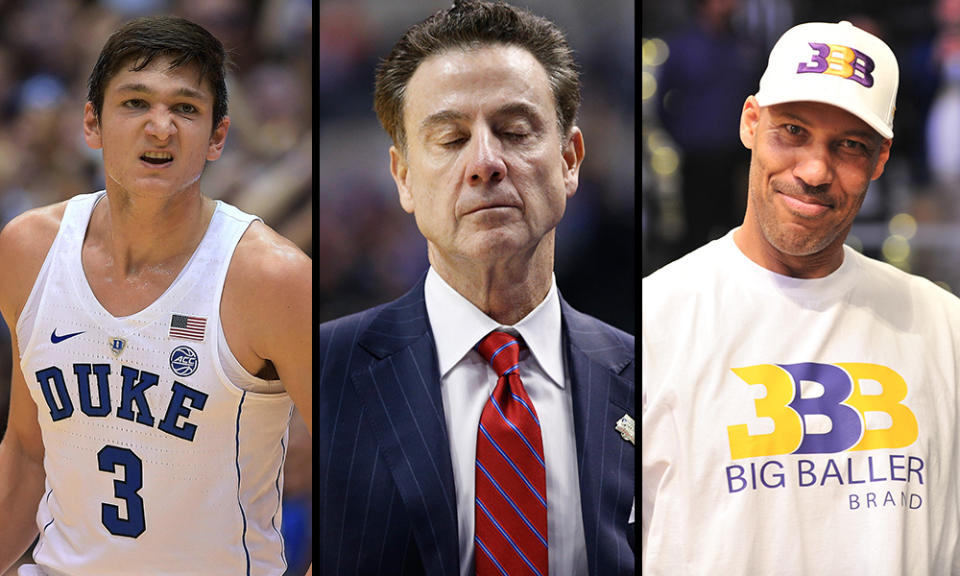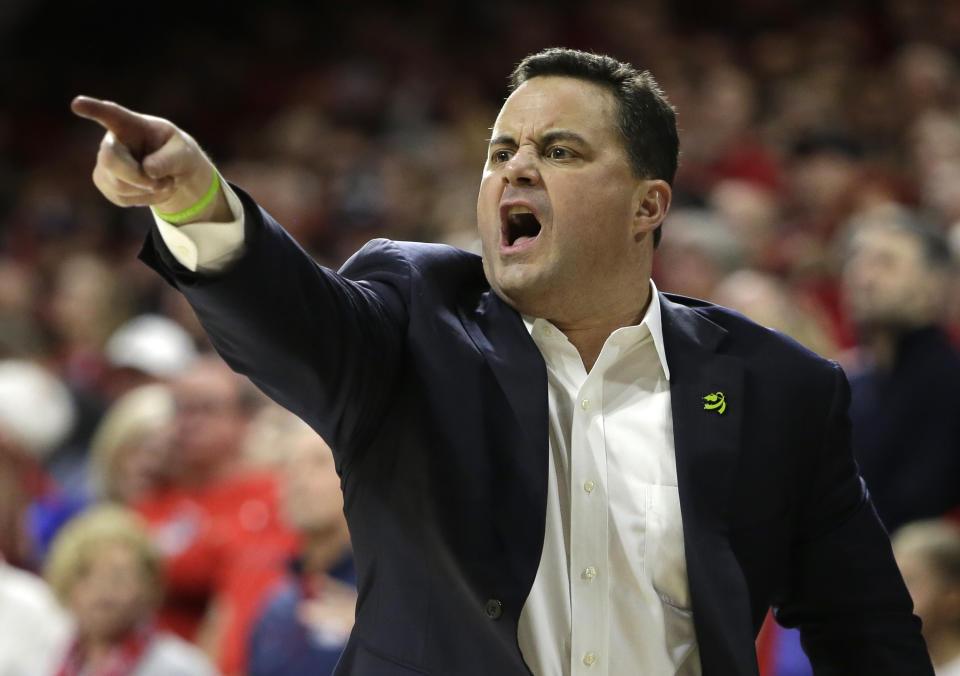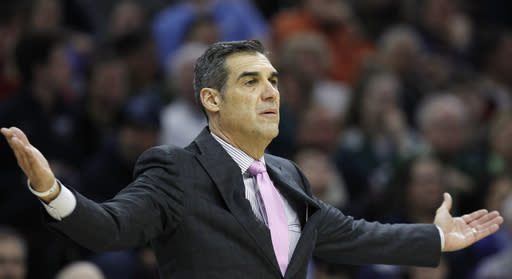Forde Minutes: What's missing this college basketball season? LaVar Ball, for one ...
Forty names, games, teams and minutiae making news in college basketball (hazmat suits sold separately at Pittsburgh, which last won an ACC regular-season game on Feb. 18, 2017) :
FIRST HALF: ADDITION BY SUBTRACTION?
[Second half: College basketball conference heat check]
For those of you who stayed rooted in football until the last Tom Brady Hail Mary pass hit the ground Sunday night, welcome to college basketball season. It’s been an odd one so far. If you want a quick catch-up on what’s been happening, it might be best to start with what’s missing.
No Balls (1). The happiest development of the season has been the unexpected exodus of LaVar Ball and his children from college hoops. Big Baller & Sons are plying their trade in Lithuania, about 14 hours away from UCLA by plane. They’re still perfectly capable of causing an international incident (see: China, November), but at least it wouldn’t be college basketball’s problem anymore. Good riddance to the clown. The people championing him as a caring father and savvy marketer last spring certainly seem to have quieted down.
No Grayson Allen drama (2). The good news for Duke is that Allen has kept his flailing feet and hands to himself this season, instigating nothing with opponents and requiring no enabling from his coaches. The bad news is that he also became something of a non-factor in January, during which the Blue Devils went 6-3. Allen averaged 10 points, 4.3 assists and 3.9 rebounds in the month, shooting just 24.5 percent from 3-point range and 42.4 percent from inside the arc. Duke likely will need more from him in February if it wants to stay in the mix for an NCAA tournament No. 1 seed.
No Rick Pitino (3). When Louisville abruptly (and quite justifiably) fired the giant energy source that was Pitino last fall, it left a vacuum at a power program that hasn’t been filled. Without the lightning-rod figure on the sideline, the Cardinals (16-8 and unranked) aren’t quite as good and aren’t quite as interesting. That’s no fault of 32-year-old interim coach David Padgett, who is doing the best he can in a thankless position, but in a sport where coaches are huge figures, Louisville’s stature has shrunk.

No certainty where the ongoing federal investigation (4) stands. When Purdue president Mitch Daniels fired off a caustic Washington Post op-ed last week about the state of college basketball, it was a jarring reminder of the mushroom cloud hovering over the sport. The piece, aimed at Condoleezza Rice in her role as head of the NCAA committee appointed to study and theoretically fix corruption in college hoops, was a bit scattershot. It oversimplified the game’s problems, basically dumping them all on “one-and-done culture,” when most major issues predated that phenomenon by a decade or more. But what the piece lacked in specificity, it made up for in volume. When a sitting university president throws the entire sport under the bus, people listen. And it served as a wakeup call for those who had lapsed into deluded thinking that because the feds are no longer holding press conferences, they’ve gone away. That doesn’t appear to be the case — but nobody knows exactly where the process stands. Which means a general uneasiness should perpetuate through February and into the sport’s showcase month.
No blue-blood domination (5). There are eight programs that have won three or more national titles: UCLA, Kentucky, North Carolina, Duke, Indiana, Kansas, Connecticut and Louisville. Only one of them (Duke) is in the current Ken Pomeroy top 10 — and the Blue Devils are coming off a loss to the worst team in the Big East, St. John’s. As for the rest: UCLA (16-7) is a bubble team; Kentucky (17-6) is arguably at its lowest ebb since the 2013 NIT team; North Carolina (17-7) is 1-4 on the road in the ACC, and that one win was by a point over injury-depleted Notre Dame; Indiana (13-12) has been blown out by Indiana State and Fort Wayne, among other indignities; Kansas (18-5) has stunningly lost three times in Phog Allen Fieldhouse, where it had lost just once in the previous three seasons; Connecticut (11-12) is tied for ninth in the American Athletic Conference and may need to fire the coach who won the 2014 national title, Kevin Ollie; and Louisville, as previously mentioned, is just kind of sitting there on the fringe of relevance. Important to note: There’s nothing wrong with new blood at the top. Unless you’re a CBS exec worried about selling the NCAA tournament to casual fans.
IS THIS FINALLY THEIR YEAR?
Last season, Mark Few (6) of Gonzaga finally broke through the Final Four barrier, in his 18th NCAA tournament try. It was a cathartic accomplishment that, fair or not, forever changed the way people view Few — if you have a Final Four on your résumé, you’ve entered an elite club. Few is in the club now, for life.
There are an unusually large number of strong candidates to be this year’s Mark Few, positioned to advance their already accomplished careers to a new level of validation. The list:
Tony Bennett (7), Virginia.
Current situation: Cavaliers are 22-1 overall, 11-0 in the ACC and in first place by three games. They’re ranked No. 2 in the human polls, No. 2 in Ken Pomeroy’s ratings and No. 3 in Jeff Sagarin’s ratings.
Previous NCAA tournament appearances: Seven, five with Virginia and two with Washington State.
Highest NCAA seeding: No. 1, in 2014 and ’16.
Closest brush with the Final Four: A horrifying 2016 regional final collapse, wherein the Cavaliers unraveled against Syracuse’s full-court pressure and blew a 13-point lead in the final 10 minutes.
Will Bennett break through this year? Virginia is as slow as ever — dead last nationally in tempo for the second straight season — but perhaps better than ever defensively. And the key distinction with this team is that it is one of Bennett’s more efficient offensively. Virginia has three key players shooting 41 percent or better from the 3-point line for the first time in the Bennett Era, and the Cavaliers are more fastidious than ever with the basketball (10th nationally in turnover rate). That doesn’t mean Virginia is immune to a March meltdown if the shots aren’t falling or they’re pulled into a faster pace, but the Minutes believes this is the year Bennett and his team make the Final Four.
Sean Miller (8), Arizona.
Current situation: Wildcats are 19-5 overall, 9-2 and in first place in the Pac-12. They’re No. 13 in the human polls, No. 23 in KenPom and No. 14 in Sagarin.
Previous NCAA tournament appearances: 10, six with Arizona and four with Xavier.
Highest NCAA seeding: No. 1, in 2014.
Closest brush with the Final Four: Made four regional finals, with the toughest loss coming as a No. 1 in 2014 against fifth-seeded Wisconsin. Arizona led most of the game before being forced into overtime. Trailing by a point in the final seconds, the Wildcats had several chances at the game-winning basket go awry.
Will Miller break through this year? Not feeling it. In 7-foot monster Deandre Ayton and guard Allonzo Trier, Arizona has the pro-level talent you look for in a national title contender. But the pieces still don’t fit together ideally, especially at the defensive end — Arizona’s No. 106 Pomeroy ranking defensively would be the worst to make a Final Four in 15 years, since Marquette in 2003. And the Pac-12’s status as a huddled mass of mediocrity doesn’t inspire confidence that Arizona will be sufficiently battle-tested for the second weekend of the Big Dance.

Bruce Pearl (9), Auburn.
Current situation: The nation’s biggest surprise team is 21-2 overall, 9-1 in the SEC and leading the league by two games. The Tigers are No. 8 in the AP poll, No. 9 in the coaches poll, No. 8 with Pomeroy and No. 20 with Sagarin.
Previous NCAA tournament appearances: eight, two with Milwaukee and six with Tennessee.
Highest NCAA seeding: No. 2, in 2006 and ’08.
Closest brush with the Final Four: Regional final, in 2010. As a No. 6 seed, Tennessee surprised Ohio State in the Sweet 16 and led most of the game in the Elite Eight against Michigan State. But the Spartans made one of two free throws inside the final two seconds to win by a point.
Will Pearl break though this year? Forget lacking Final Four experience, the Tigers don’t even have any NCAA tournament experience outside of their coaching staff. It can be done that way — South Carolina did it last year — but it’s a rarity. Auburn also is dealing with a height deficit that could eventually put a ceiling on its tournament upside. In a non-federal investigation vacuum, Pearl is the leading candidate for national coach of the year honors at the moment — but a Final Four may still have to wait.
Matt Painter (10), Purdue.
Current situation: Boilermakers are 23-2, 12-0 in the Big Ten and leading the league by a game. They’re No. 3 in the human polls, No. 3 with Pomeroy and No. 2 with Sagarin.
Previous NCAA tournament appearances: 10, one with Southern Illinois and nine with Purdue.
Highest NCAA seeding: No. 3, in 2011.
Closest brush with the Final Four: In 2010, the Boilermakers were 23-3 and ranked No. 3 nationally when key player Robbie Hummel tore his ACL. Without Hummel, Purdue advanced to the Sweet 16 before losing to eventual national champion Duke.
Will Painter break through this year? If ever there were a year, this is it. Purdue has seniors, size, shooters and defenders. The Boilers seemingly are athletic enough. With just six regular-season games left, they have staked a strong claim to a No. 1 seed. If Purdue fans want an X-factor to worry about, the week off after the Big Ten tournament and before the start of the Big Dance is it. But as of now, The Minutes is ready to ride with Purdue as a Final Four team.
Mick Cronin (11), Cincinnati.
Current situation: Bearcats are 21-2 overall, 10-0 in the AAC and leading the conference by three games. They are No. 6 in both human polls, No. 5 with Pomeroy and No. 6 with Sagarin.
Previous NCAA tournament appearances: nine, two with Murray State and seven with Cincinnati.
Highest NCAA seeding: No. 5, in 2014.
Closest brush with the Final Four: Sweet 16, 2012. Sixth-seeded Cincinnati trailed No. 2 seed Ohio State most of the game before rallying to take a brief lead midway through the second half, but then the Bearcats were blown out in the final eight minutes.
Will Cronin break through this year? A prediction better made two weeks from now, after Cincinnati has played SMU and Houston on the road and Wichita State at home between Feb. 11-18. The only better defensive team is Virginia, and the Bearcats overcome some of their offensive shortcomings by waylaying teams on the offensive glass. Still, it’s hard to trust a team that doesn’t shoot it great from two-point range or one-point range, and hasn’t played with the pressure of a high seed before. Pass.
CIRCLE OF TRUST
Making the Final Four is one thing. Winning a national title is something altogether different. Each week, The Minutes will list the teams in the Circle of Trust that are reliable championship candidates — the kind you can write with confidence on that last blank line in your NCAA tournament pool.
Right now, it’s a small circle. In fact, it’s inhabited by one team: Villanova (12).

Why the Wildcats over Virginia and Purdue, the other two teams that have distanced themselves a little bit from the rest of the national pack? Because coaching experience matters.
Only two of the last 17 national championships were won by coaches making their first trip to the Final Four: Kevin Ollie (13) in 2014 and Bill Self (14) in 2008. Jay Wright, obviously, has been there before — in 2009 and again in 2016, when Villanova won it all by the most dramatic means possible. While Bennett or Painter might break through to the Final Four this year, winning it all is another step up the Werner Ladder. Wright had his initiation in ’09 and validation in ’16.
Beyond coaching experience, of course, is the fact that ‘Nova is really good. Again. The level of consistency achieved by Wright is remarkable — the Wildcats are well on their way to a fourth straight season of 30 wins, something neither Mike Krzyzewski nor Roy Williams has accomplished. A return to health of underrated guard Phil Booth (out with a broken hand) would certainly help their cause, and some more vigilant defense. But ‘Nova is running offensive clinics in the Big East right now, with no cessation in sight.
YOUR FAMOUS EX-NBA PLAYER TURNED COACH? HE’S PROBABLY NOT DOING VERY WELL
When Chris Mullin (15) and St. John’s shocked the world Saturday by beating Duke in Madison Square Garden, it was easily the biggest victory of the former Dream Teamer’s three-season coaching tenure at his alma mater. The rest of his résumé is rotten.
Mullin is 33-56 at St. John’s, a ghastly 8-39 in Big East games. The current team is 0-11 in league play. And while eight of those league losses are by single digits, indicating that the Red Storm is not that far away, you wonder whether a more adept bench coach might have gotten them over the hump in a few of those games. (To that point: The St. John’s inbounds play against Duke that resulted in the biggest shot of the game, a 3-pointer by Shamorie Ponds, appeared on TV to be drawn up by assistant coach Greg St. Jean while Mullin was a curious onlooker.)
The larger point here is this: Hiring a former NBA star player isn’t a guarantee that you’ve landed a great college coach. Mullin could be following the footsteps of Clyde Drexler and Isiah Thomas, all-time NBA greats who quickly proved that the coaching life wasn’t for them.
Mark Price (16) finished proving that earlier this season. He was fired nine games into his third season at Charlotte, sent packing with a 30-42 record.
Is Patrick Ewing (17) next? The greatest player in Georgetown history will certainly get plenty of time to prove or disprove himself, but early returns are not stellar. The Hoyas are 13-9 overall but just 3-8 in the Big East, and two of those league wins are over Mullin and St. John’s. Georgetown’s current No. 101 Ken Pomeroy ranking is the program’s worst since Craig Esherick was the coach in 2004.
However, there is hope for Avery Johnson (18) at Alabama. In his third season, the former NBA point guard has the Crimson Tide in position (for now) for their first NCAA bid since 2012 and just the second since 2006. (Every six years, like clockwork, the Tide makes the Big Dance.) Alabama has been wildly inconsistent the last two weeks, with big wins at Florida and over Oklahoma and puzzling losses to Mississippi and at home to Missouri. If they can go .500 the rest of the regular season, they should be in decent shape for a bid.
The jury is out on Danny Manning (19) at Wake Forest. His fourth Demon Deacons team (9-14, 2-9 in the ACC) has regressed to the level of his first and second, which isn’t good. Last year looked like the breakthrough year, with Wake going 19-14 and making the NCAA tourney for the first time since 2010, but losing John Collins to the NBA as a sophomore left a void that hasn’t been filled.
One former NBA star to keep an eye on: Dan Majerle (20) at Grand Canyon. In his fifth year at the school, Majerle is well on his way to a third straight 20-win season. After transitioning to Division I, the Antelopes (17-7) are eligible for the NCAA tournament for the first time this year. They might not get there in a Western Athletic Conference currently dominated by New Mexico State, but Majerle could be a rising star in the coaching ranks.
More from Yahoo Sports:
• Distraught Patriots star: ‘I could have changed that game’
• Decline in NFL viewership continues with Super Bowl
• Charles Robinson: For Brady, tears and concerns over Pats’ dynasty

